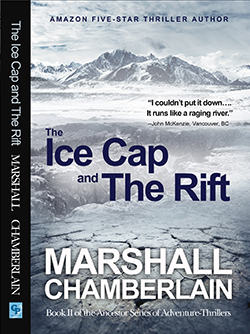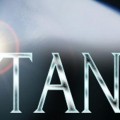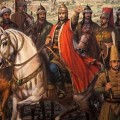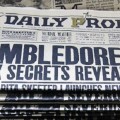
The cover and title says it all.
The Ice Cap and the Rift is the second novel in Marshall Chamberlain’s the Ancestor Series of Adventure Thrillers. John Henry Morgan, director of the United Nations’ Institute for the Study of Unusual Phenomenon (ISUP), is still reeling from the events in the first novel (The Mountain Place of Knowledge) when a combo-quake of unprecedented size occurs without any prior warning. The situation escalates when a team in Iceland detects the presence of strange, hidden structures within the newly formed rift that pre-date the birth of human civilisation. Morgan has encountered evidence of advanced, ancient technology before, and recognises these structures as having been built by mysterious beings they’ve named the Ancestors. He has to secure a UN presence at the rift, and balance conflicting international interests as different nations scramble to secure the technology within the rift for themselves.
Hounding Morgan at every step is Dick Murray, director of the CIA. Murray only cares about results and the protection of his country, a man desperate for success after being outmanoeuvred by the Chinese the last time they discovered Ancestor technology. Morgan needs his help, but every bit of assistance Murray offers is a double-edged sword. Thankfully, Morgan isn’t alone. Doctor Mary Ellen, his colleague, friend and partner, was also witness to the capabilities of Ancestor technology before, and uses her extensive scientific knowledge and force of personality to help ISUP succeed against the odds. Operating from within the shadows is Ling Soo, the Chinese Minister of Intelligence, a dangerous and canny opponent. Using deception and the co-operation of international allies, he proves an adept opponent equally capable in both the political and military fields.
The dual UN-Cambridge team investigates the rift in the ice cap while trying to prevent too much information from leaking out to the various international factions eager for a piece of the pie. What they find is a fully operational habitat, with several flying vehicles that are still in top condition. The flying vehicles are saucer-shaped crafts, and raise questions about humanity’s origins, and whether our history is as complete or short as we’d been led to believe. Before the full implications of the discovery can be worked through, the Chinese manage to secure the information about the rift’s contents and execute a daring plan to steal one of the flying saucers. It’s up to Murray and Morgan to set aside their differences in order to track and recover the stolen craft.
The Ice Cap and the Rift reads like a story-driven political thriller with a sci-fi twist. In style it’s reminiscent of Tom Clancy in that Marshall explains the workings of his world in great detail. His research into a variety of topics lends this text believability and weight. You get a very real sense that he knows what he’s talking about regarding the way the various organisations and modern technology works. The unfortunate trade-off, however, is that the narrative flow gets interrupted by lengthy exposition.
The blending of the science fiction into the real-world setting is handled very well, with a careful reverence that’s not often experienced in novels. The mystical and spiritual nature of the Ancestors is well defined because of this, lending a strange metaphysical feeling to everything centred on their works. From the get-go he manages to arouse intrigue as to what we have in the rift, and who its mysterious architects were.
Unfortunately, this reverence seems to disappear when the aura of mystery vanishes. The UN team has no great difficulty in getting into the newly revealed habitat, and spend more time sweeping the area for CIA bugs. Once inside, the descriptions of the habitat’s controls give it a strangely ‘Fisher-Price’ feel. Scientists don’t spend much time puzzling through symbols or controls, and in fact have no hassle deciphering how everything works. The fact that much modern human technology within the novel’s setting seems on par with that of the Ancestors – virtual environments, advanced invisibility cloaking technology, satellite mounted lasers – makes the discovery in the rift feel a little underwhelming. There are even two chapters within the novel where we are treated to modern, living Ancestors as the viewpoint characters in order to understand their motives. Had the sense of mystery been preserved, then we’d be able to maintain the sense of wonder the Ancestors are supposed to engender.
One of the other stumbling blocks for the novel is the sheer volume of characters. Aside from Morgan, Murray, Ellen and Soo, the cast of characters is extensive. With so many individuals, running the gamut from pilots, secret agents, terrorists and academics, characterisation is kept brief of a necessity, with most characters getting a short introduction and a single defining characteristic. In the worst examples the supporting characters are ethnic or occupational stereotypes. This makes many of them feel more like caricatures than actual flesh-and-blood individuals. Fewer characters performing many of the same roles, or more face-time for some characters, would really strengthen the impact they make.
Chamberlain’s descriptions are stronger than his characters, but inconsistent. At times he paints a scene vividly using multiple senses; I’m still stuck remembering the nutty smell of a cup of coffee Morgan has towards the final chapters. At other times, it feels like Chamberlain is watching a movie and describing it to us, his readers, with a certain level of dispassion. This creates a distance, something dangerous in a novel that requires reader investment in order to get swept up in the action. The worry is that the weak descriptions far outweigh the good ones. Despite that, the tension of the final chapters prompted further reading, the reader trying to work out the intricacies of the Chinese plot alongside the protagonists.
There’s much to recommend in The Ice Cap and the Rift. Chamberlain lends his world both a sense of credibility and mysticism. However, the presence of many weak characters hampers our involvement. Sacrificing descriptions for exposition in order to preserve the fast pace of his novel created further distance between readers and the action. If you’re looking for a light adventure novel with global conflict and alien artefacts, then this might just be the book for you.
With a release date of 15th October 2014, you can pre-order the ebook on multiple platforms, or start with the first book in the series.
This book was reviewed using a copy provided by the publishers for that purpose
© 2014, The Indie Mine. All rights reserved.





